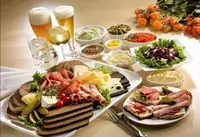The european

It is very difficult, and sometimes almost impossible to talk about European cuisine as a holistic phenomenon. Europe is inhabited by many peoples who are strikingly different from each other in historical and cultural traditions, which leaves its mark on culinary preferences. The geographical and climatic features of European countries, which are also surprisingly diverse, are also of great importance.
Nevertheless, it is possible to characterize European cuisine. To do this, it is worth finding its differences from cuisines in other regions of the world. So, for example, the differences between European cuisine and oriental culinary traditions consist in much less use of spices and spices. Europeans advocate the preservation of the natural taste of products, and it is well known that various additives change this taste.
It is believed that European food is much healthier than Eastern food, although no one has canceled the secret of Eastern longevity, which is based on the peculiarities of nutrition. European cuisine is mainly light and natural.
Sauces are not an integral part of dishes, they are rather a kind of addition to them. Sauces, however, in the recipes of European cuisine are huge. There are more than three thousand of them.
It is generally recognized that the basis of European cuisine has developed in France. French cuisine had a powerful influence not only on other European culinary traditions, but also on the traditions of many other peoples of the world. In particular, one example is the use of wine, liqueur and cognac in the preparation of various dishes. This tradition was adopted and assimilated in many countries.
It's no secret that vegetables form the basis of recipes for European cuisine. This fact also speaks of the benefits of European cuisine. The main principle of European chefs can be called freshness and naturalness, which is manifested primarily in the choice of products.
The main type of meat in the recipes of European cuisine can be considered beef. Beef is served predominantly fried or baked. Beefsteak, anthrecote, roast beef, escalop, schnitzel are typical meat dishes of European cuisine found in almost every culinary tradition of this region. Vegetable or flour products serve as a side dish for these dishes.
Europeans wash down on food with wine or beer. A distinctive feature of European cuisine is that each meal precedes the so-called aperitif. This is a small amount of alcohol that is consumed before eating and contributes to arousing appetite and improving digestion.
Europeans are very scrupulous about desserts. Desserts of European cuisine are always exquisite and delicious. Sweets are usually washed down with coffee or tea. Eggs are an integral part of European cuisine. Eggs are consumed as an independent dish, such as omelette or scrambled eggs, and are also added to other dishes, in particular, to confectionery.
Today, European cuisine is one of the most popular cuisines in the world. Each dish of European cuisine can be compared to expensive perfumes - it necessarily has one or more prevailing notes. The most appropriate epithet for the European culinary tradition is the word "classical. " Europeans are very pedantic about food. However, with all this, European cuisine is infinitely diverse, as much as the number of preferences, tastes and temperaments combined by the common name "European" is diverse.
 Español
Español Français
Français Português
Português Русский
Русский 简体中文
简体中文 繁體中文
繁體中文 日本語
日本語 한국어
한국어 العربية
العربية Türkçe
Türkçe Қазақ
Қазақ Deutsch
Deutsch Italiano
Italiano Українська
Українська
